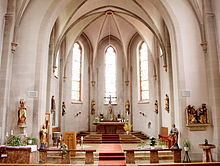Admin. region Tübingen Elevation 631 m (2,070 ft) Area 31.24 km² Local time Sunday 10:23 AM Dialling code 07577 | Time zone CET/CEST (UTC+1/+2) Population 2,257 (31 Dec 2008) Postal code 72519 Administrative region Tübingen | |
 | ||
Weather 9°C, Wind N at 13 km/h, 73% Humidity | ||
Veringenstadt is a town in the district of Sigmaringen, in Baden-Württemberg, Germany. It is situated 10 km north of Sigmaringen.
Contents
- Map of Veringenstadt Germany
- Geographical location
- Geology
- History
- Municipality
- Crest
- Twinning
- Museums
- Buildings
- Teams
- Transportation
- Established businesses
- Education
- Freemen
- Sons and daughters of the city
- Literature
- References
Map of Veringenstadt, Germany
Geographical location
Veringenstadt is situated in the valley of the Lauchert, a tributary of the Danube, between Gammertingen and Sigmaringen. The municipality area is 3125 hectares.
Geology
The municipality Veringenstadt lies on the Lauchertgraben (Lauchert trench). East of Veringendorf a petrified sponge reef can be seen, which was created 140 million years ago.
History
The area of the present municipality Veringenstadt was already settled in early historical times. The town itself is an ancient settlement which was already mentioned in a document around the year 786. It derives its name from a certain "Fara" or "Faro", was so well earlier "Faringa", about 1130 Veringin, later always Veringen. The counts of Veringen were one of the wealthiest and most respected dynasties of the 11th and 12th century in southern Germany. Through targeted resettlement of population from the surrounding hamlets succeeded about 1250 the foundation of the city of Veringen (today Veringenstadt). After the Thirty Years' War (1618–1648) about 1650 farmers from Tirol were recruited for Veringenstadt and settled here. From 1827 to 1925 Veringenstadt belonged to Oberamt Gammertingen. 1850 it became as part of the principality Hohenzollern-Sigmaringen prussian, and belonged to the province of Hohenzollern. Ore was mined in the 18th and 19th century. Since 1927 the municipality belongs to the district of Sigmaringen. Since 1945, the city belonged to Württemberg-Hohenzollern, which opened in Baden-Württemberg in 1952. By the inclusion of expellees after 1945, the population of Veringenstadt has nearly doubled in the 1950s. On February 1, 1972 Hermentingen was incorporated. The incorporation of Veringendorf was on January 1, 1975.
Municipality
The municipality combines the main locality Veringenstadt with the two villages Hermentingen and Veringendorf.
Crest
The emblem of Veringenstadt was officially approved 1947. Already 1320 a lion and a deer rod was used as coat of arms. The coat of arms shows a golden shield a red lion under a layer of a red deer rack. The lion comes from the Habsburg coat of arms, the deer bar is derived from the coat of arms of the Counts of Veringen.
Twinning
Veringenstadt maintains since 2012 a partnership with the city of Zwettl an der Rodl in Austria.
Museums
Buildings
Veringenstadt is dominated by a medieval core with half-timbered houses, the castle Veringen and religious buildings:
Electrical works (Brothers Haux 1902) in Veringendorf
Teams
In Veringenstadt are more than 30 clubs. With currently 450 members, the TSV is the largest. (as of 15 January 2011).
Transportation
The municipalities Veringenstadt and Veringendorf were connected to the rail network by the Kleinengstingen-Sigmaringen railway. The Göpfelstein was tunneled at Veringenstadt. The 91-meter long tunnel was built by Italian workers. The first train passed through the tunnel Veringen at Christmas, 1907, the line was opened in 1908. The Federal Highway 32 led originally through the Veringenstadt center. Between 1975 and 1980, a road tunnel was built. Today daily drive around 5000 vehicles through the Schlossberg tunnel. The Public transport is guaranteed by the Verkehrsverbund Neckar-Alb-Donau (NALDO). The community is located in the comb 442.
Established businesses
The Schwörer Haus maintains in Veringenstadt a factory making fort massif houses, ceilings, precast concrete, chimneys.
Education
There are two schools in the nucleus. A primary school and since the school year 2010/2011 a branch of the Werkrealschule Gammertingen. The school building of the Alb-Lauchert School in Veringenstadt, an elementary school, was built in 1953. In Veringenstadt there is a day care center with full-day care, in Veringendorf a kindergarten, which also accommodates children under three years.
